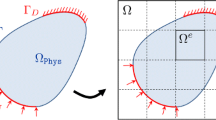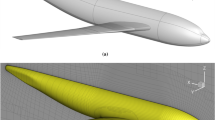Abstract
A Cartesian shrink-wrapping technique has been investigated in this study to automatically generate triangular surface meshes for 3D dirty geometries. The geometries dealt in this paper are defined by a faceted representation and have flaws such as non-conforming edges, gaps, and overlaps. The proposed technique addresses a way of constructing triangular surface meshes for upstream fluid simulations in design processes without extensive manual labor for healing complicated dirty geometries. The meshing procedure begins by overlaying a Cartesian grid onto the dirty geometries and the Cartesian cells are adaptively refined until a target resolution is achieved while recording intersections with geometric facets in cells. An initial watertight shell called the wrapper surface is constructed by selectively extracting the boundary sides of the intersected cells. The wrapper surface is improved by a combination of operations such as projecting nodes onto the geometry, adjusting nodes on the geometry, and editing local triangular faces to achieve a better geometric approximation. The meshes generated using the presented technique may not precisely represent the details of the input geometries, but their quality is good enough to quickly deliver upstream fluid analysis solutions with significantly reduced engineering time for problems of extreme complexity such as the full underhood fluid/thermal analysis for automobiles. Mesh generation experiments have been carried out for complicated geometries, and results from some applications are presented in this paper.



















Similar content being viewed by others
References
Beall MW, Walsh J, Shephard MS (2003) Accessing CAD geometry for mesh generation. In: Proceedings of 12th international meshing roundtable, pp 33–42
Sheffer A, Blacker T, Clements J, Bercovier M (1997) Virtual topology operators for meshing. In: Proceedings, 6th international meshing roundtable, pp 49–66
Steinbrenner JP, Wyman NJ, Chawner JR (2000) Fast surface meshing on imperfect CAD models. In: Proceedings 9th international meshing roundtable, pp 33–41
Kobbelt L, Vorsatz J, Labsik U, Seidel HP (1999) A shrink wrapping approach to remeshing polygonal surfaces. Comp Grap Forum 18(3):119–130
Shephard MS (1985) Automatic and adaptive mesh generation. IEEE Trans Magn 21:2482–2489
Schneiders R (1995) Automatic generation of hexahedral finite element meshes. In: Proceedings, 4th international meshing roundtable, pp 103–114
Aftosmis MJ, Berger MJ, Melton JE (1997) Robust and efficient Cartesian mesh generation for component-based geometry, AIAA Paper 97-0196
Wissink A, Chand K, Gunney B, Kapfer C, Berger M, Kosovic B, Chan S, Chow F (2005) Adaptive urban dispersion integrated model, 8th American Meteorological Society annual meeting, Atlanta, GA
Wang JZ, Srinivasan K (2002) An adaptive Cartesian grid generation method for ‘Dirty’ geometry. Int J Numer Meth Fluids 39:703–717
CD-Adapco (2008) Surface wrapper. http://www.cd-adapco.com/products/STAR-CCM_plus/common/surface-wrapper.html
Sharc Ltd (2008) Harpoon—the extreme mesher. http://www.sharc.co.uk/index.htm
CFDRC (2008) CFD-VisCART. http://www.cfdrc.com/serv_prod/cfd_multiphysics/software/ace/viscart.html
Peric M (2004) Simulation of flows in complex geometries: new meshing and solution methods. In: Proceedings NAFEMS seminar: “Simulation of complex flows (CFD)—Application and trends”, Niedernhausen, Wiesbaden
Bischoff S, Pavic D, Kobbelt L (2005) Automatic restoration of polygonal models. ACM Trans Graph 24(4):1332–1352
Yerry MA, Shephard MS (1984) Automatic three-dimensional mesh generation by the modified-octree technique. Int J Numer Meth Eng 20:1965–1990
Zhu J, Blacker T, Smith R (2002) Background overlay grid size functions. In: Proceedings 11th international meshing roundtable, pp 65–74
Garland M, Heckbert PS (1997) Surface simplification using quadric error metrics. In: Proceedings 24th annual conference on computer graphics and interactive techniques, pp 209–216
Hermann LR (1976) Laplacian-isoparametric grid generation scheme. J Eng Mech Div Am Soc Civil Eng 102:749–756
Taubin G (1995) Curve and surface smoothing without shrinkage. In: Proceedings 5th int. conf. computer vision, pp 852–857
Vollmer J, Mencl R, Müller H (1999) Improved Laplacian smoothing of noisy surface meshes. Comp Graph Forum 18(3):131–138
Zhang H, Fiume E (2002) Mesh smoothing with shape or feature preservation. Proc Comp Graph Int 2002:167–182
Author information
Authors and Affiliations
Corresponding author
Rights and permissions
About this article
Cite this article
Lee, Y.K., Lim, C.K., Ghazialam, H. et al. Surface mesh generation for dirty geometries by the Cartesian shrink-wrapping technique. Engineering with Computers 26, 377–390 (2010). https://doi.org/10.1007/s00366-009-0171-0
Received:
Accepted:
Published:
Issue Date:
DOI: https://doi.org/10.1007/s00366-009-0171-0




